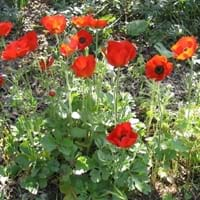Life Span
Perennial
Perennial
Type
Bulb or Corm or Tuber
Bulb or Corm or Tuber
Origin
South America
Eastern Europe, Northern Africa, Western Asia
Types
Pamianthe cardenasii , Pamianthe parviflora , Pamianthe peruviana
tecolate strain
Habitat
All sorts of environments
Lawn, Temperate Regions
USDA Hardiness Zone
8-10
7-11
Habit
Clump-Forming
Upright/Erect
Flower Color
White
White, Yellow, Red, Purple, Orange, Pink
Flower Color Modifier
Bicolor
Bicolor
Fruit Color
Green
Not Available
Leaf Color in Spring
Dark Green
Blue Green
Leaf Color in Summer
Light Green
Light Green
Leaf Color in Fall
Several shades of Green
Several shades of Green
Leaf Color in Winter
Light Green
Light Green
Leaf Shape
Strap shaped
Palmate
Plant Season
Spring, Summer, Fall
Spring, Summer
Sunlight
Partial Sun, Partial shade
Full Sun
Type of Soil
Loam, Sand
Loam, Sand
The pH of Soil
Acidic, Neutral, Alkaline
Acidic, Neutral, Alkaline
Soil Drainage
Average
Well drained
Bloom Time
Spring, Late Spring, Early Summer, Summer, Late Summer
Late Spring, Early Summer
Tolerances
Drought
Drought
Where to Plant?
Ground, Pot
Container, Ground, Pot
How to Plant?
Offsets
From bulbs, Seedlings, Transplanting, Vegetative Reproduction
Plant Maintenance
Medium
Medium
Watering Requirements
Keep the ground moist but not water-logged
Keep the Soil well drained, Requires plenty of water during the growing season
In Summer
Lots of watering
Lots of watering
In Spring
Moderate
Moderate
In Winter
Average Water
Average Water
Soil pH
Acidic, Neutral, Alkaline
Acidic, Neutral, Alkaline
Soil Type
Loam, Sand
Loam, Sand
Soil Drainage Capacity
Average
Well drained
Sun Exposure
Partial Sun, Partial shade
Full Sun
Pruning
Pinch or prune as they grow to promote branching and bushiness, Remove damaged leaves, Remove dead branches, Remove dead leaves, Requires little pruning
Remove damaged leaves, Remove dead branches, Remove dead leaves
Fertilizers
All-Purpose Liquid Fertilizer, High phosphorus
All-Purpose Liquid Fertilizer
Pests and Diseases
Leaf spot, Mosaic viruses
Not Available
Plant Tolerance
Drought
Drought
Flower Petal Number
Single
Single, Double, Semi-Double
Foliage Texture
Coarse
Medium
Foliage Sheen
Glossy
Matte
Attracts
Bees, Birds, Bumblebees, Butterflies, Hummingbirds, pollinators
Insects, pollinators
Allergy
Unknown
Skin irritation
Aesthetic Uses
Beautification, Bouquets, Ornamental use, Showy Purposes
along a porch, deck or patio, Bouquets, Cut Flowers, Hanging Basket
Beauty Benefits
No Beauty Benefits
Not Available
Environmental Uses
Air purification
Air purification
Medicinal Uses
No Medicinal Use
Not Available
Part of Plant Used
Not Available
Flowers
Other Uses
Beneficial species for attracting pollinators, Decoration Purposes
Basketary, deer resistant, Used as Ornamental plant
Used As Indoor Plant
No
No
Used As Outdoor Plant
Yes
Yes
Garden Design
Bog Garden, Container, Feature Plant, Foundation, Mixed Border, Water Gardens
Bedding Plant, Container, Cutflower, Mixed Border
Botanical Name
HYMENOCALLIS longipetala
RANUNCULUS asiaticus
Common Name
Peruvian Daffodil, Spiderlily
Garden Ranunculus, Persian Buttercup
In Hindi
peruvian daffodil
Persian Buttercup
In German
peruvian daffodil
Asiatischer Hahnenfuß
In French
peruvian daffodil
Renoncule des fleuristes
In Spanish
Pamianthe
Persian Buttercup
In Greek
peruvian daffodil
Persian Buttercup
In Portuguese
peruvian daffodil
ranúnculo
In Polish
peruvian daffodil
Jaskier azjatycki
In Latin
peruvian daffodil
Persian Buttercup
Phylum
Magnoliophyta
Vascular plant
Class
Liliopsida
Not Available
Order
Asparagales
Ranunculales
Family
Amaryllidaceae
Ranunculaceae
Genus
Pamianthe
Ranunculus
Clade
Angiosperms, Monocots
Angiosperms, Eudicots
Tribe
Clinantheae
Ranunculeae
Subfamily
Amaryllidoideae
Unknown
Number of Species
Not Available
Importance of Peruvian Daffodil and Persian Buttercup
Want to have the most appropriate plant for your garden? You might want to know the importance of Peruvian Daffodil and Persian Buttercup. Basically, these two plants vary in many aspects. Compare Peruvian Daffodil and Persian Buttercup as they differ in many characteristics such as their life, care, benefits, facts, etc. Every gardener must at least have the slightest clue about the plants he wants to plant in his garden. Compare their benefits, which differ in many ways like facts and uses. The medicinal use of Peruvian Daffodil is No Medicinal Use whereas of Persian Buttercup is Not Available. Peruvian Daffodil has beauty benefits as follows: No Beauty Benefits while Persian Buttercup has beauty benefits as follows: No Beauty Benefits.
Compare Facts of Peruvian Daffodil vs Persian Buttercup
How to choose the best garden plant for your garden depending upon its facts? Here garden plant comparison will help you to solve this query. Compare the facts of Peruvian Daffodil vs Persian Buttercup and know which one to choose. As garden plants have benefits and other uses, allergy is also a major drawback of plants for some people. Allergic reactions of Peruvian Daffodil are Unknown whereas of Persian Buttercup have Skin irritation respectively. Having a fruit bearing plant in your garden can be a plus point of your garden. Peruvian Daffodil has no showy fruits and Persian Buttercup has no showy fruits. Also Peruvian Daffodil is not flowering and Persian Buttercup is not flowering . You can compare Peruvian Daffodil and Persian Buttercup facts and facts of other plants too.





